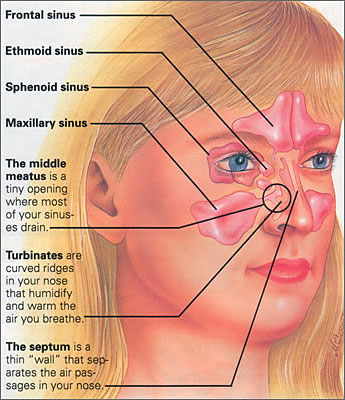Sinuses
What is sinusitis?
Sinusitis is the inflammation of the sinus cavities. Inflammation occurs when there is an obstruction and undrained collection of pus or mucus in one or more of the sinuses.
 The body’s nasal and sinus membranes have similar responses to viruses, allergies, and bacterial infections. Membranes become swollen and congested as the amount of blood passing through the nasal turbinates increases. This congestion causes obstruction, pain, and pressure. Mucous production increases during inflammation resulting in a drippy, runny nose. This drainage thickens over time, slowing their clearing and possibly opening the sinuses to other bacterial infections.
The body’s nasal and sinus membranes have similar responses to viruses, allergies, and bacterial infections. Membranes become swollen and congested as the amount of blood passing through the nasal turbinates increases. This congestion causes obstruction, pain, and pressure. Mucous production increases during inflammation resulting in a drippy, runny nose. This drainage thickens over time, slowing their clearing and possibly opening the sinuses to other bacterial infections.
There are two common types of sinusitis: acute sinusitis and chronic sinusitis.
Acute Sinusitis
Acute sinusitis is a short-term condition that typically follows a cold and lasts for up to three weeks. This type responds well to antibiotics and decongestants, and sufferers can experience a complete recovery.
Chronic Sinusitis
A tell-tale sign of a chronic problem is that a person suffers at least four reoccurrences of acute sinusitis for more than three weeks in a 12-month period.
Chronic sinusitis is much more difficult to treat with antibiotics and decongestants; these remedies are not as successful in relieving a patient from the symptoms. Patients may need combination therapies using nasal steroids with antibiotics, antihistamines, and decongestants, or surgery to remove enlarged tissue such as polyps, may be necessary.
Endoscopic Sinus Surgery
Endoscopic sinus surgery (endoscopy) is a technique that allows the doctor to clearly see and operate inside the patient’s sinuses to remove blockages. Because it causes little tissue damage, the patient has less swelling, bleeding, and discomfort than with external open surgery, and there is no visible scarring. Endoscopic sinus surgery also results in a less painful recovery with quicker relief from symptoms. Endoscopy is most effective when the patient also takes steps to control future colds and other infections or allergies – the most common causes of sinus problems.
The endoscope is a thin “telescope” that allows an inside view of your sinuses. The endoscope provides a wide-angle view of nasal and sinus walls and can be rotated to change views. Within the endoscope, threadlike fibers of glass (fiberoptic bundles) beam light into your sinuses and return precise images through an eyepiece and camera. Surgical instruments may be inserted alongside the endoscope to treat problems inside the sinuses.
The physicians at Piedmont Ear, Nose & Throat Associates have been trained to use the latest, cutting-edge technology when performing endoscopic sinus surgery including the use of a Visual Technology Imaging (VTI). VTI takes an ordinary CAT scan and allows the physician to see the sinuses in 3-D imaging during the operation.
Balloon Sinuplasty
Balloon Sinuplasty is a minimally invasive procedure that opens sinus passages. It relieves the pain and pressure associated with chronic sinusitis by opening inflamed sinuses in the same way that doctors open up blocked arteries during balloon angioplasty.
 Step 1. A balloon catheter is inserted into the inflamed sinus.
Step 1. A balloon catheter is inserted into the inflamed sinus.
Step 2. The balloon is inflated to expand the sinus opening.
Step 3. Fluid is sprayed into the infected sinus to flush out pus and mucus.
Step 4. The system is removed, leaving the sinuses open.
After Balloon Sinuplasty, the sinuses remain open, allowing the return of normal sinus drainage and relief of sinus pressure.
Balloon Sinuplasty is available to some patients as a procedure conducted in the doctor’s office under local anesthesia. Ask you doctor if you are a candidate.After Balloon Sinuplasty, the sinuses remain open, allowing the return of normal sinus drainage and relief of sinus pressure.
